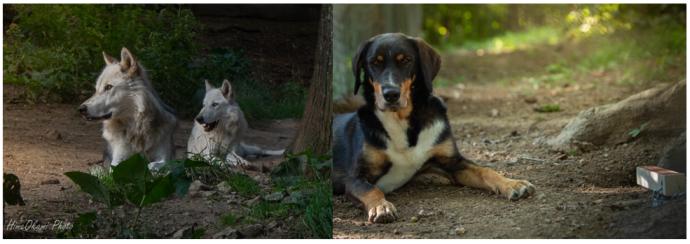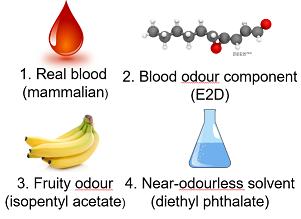Method

Animals and Housing
Three domestic dog (Canis lupus familiaris) packs (n=10) and three grey wolf (Canis lupus) packs (n=9) were observed at the Wolf Science Center (WSC) in Ernstbrunn, Austria.
All wolves and dogs at the WSC were hand-raised and lived under the same conditions. The wolves originated from reserves in Europe, Russia and North America. The dogs originated from shelters in Hungary and were of mixed breed. Wolves and dogs at the WSC were well socialised with trainers and accustomed to being tested and observed by students.
Odour stimuli

1. real blood
Deep-frozen samples of horse blood were thawed and used as a representative of mammalian blood odour.
2. trans-4,5-epoxy-(E)-2-decenal
This odorant has been identified as a volatile component in mammalian blood, which evokes a typical “metallic, blood-like” odour quality in humans (Rachamadugu 2012). The odorant was presented at a dilution of 1:100 (in diethyl phthalate) from a stock solution of 5 mg/ml.
3. iso-pentyl acetate
This odorant has been identified as a volatile component in a variety of fruits and evokes a typical “banana-like” odour quality in humans (Burdock 2005). The odorant was presented at a dilution of 1:1,000 (in diethyl phthalate).
4. diethyl phthalate
This organic solvent is near odourless and was used both as solvent for the two odorants and as control stimulus in the experiments outlined below.
These four odour stimuli were used to allow for comparison with previous studies (Arshamian et al. 2017, Nilsson 2014, Pettersson et al. 2018) that used the same method and stimuli.
Experimental procedure

Each of the four experimental conditions were presented three times to each of the six packs. Wooden logs (48 x 4.5 x 4.5 cm) were impregnated with 500 µl of an odorant (or of the near-odourless control) and placed into the enclosure of a pack.
At least two days were interspersed between consecutive tests with a given pack and the order of stimulus presentation was randomized by a computer programme within and between packs. Observations lasted for six hours a day broken up into two sessions; three continuous hours in the morning and three continuous hours in the afternoon. The observation period was between May 2018 and September 2018.
Responsible for this page:
Director of undergraduate studies Biology
Last updated:
05/07/19
